
- Share via
SANTA MARIA ZACATEPEC, Mexico — The men and boys gathered in the early morning darkness outside an Oxxo convenience store, eyeing a stretch of damp fields behind it.
They passed out cigarettes, laughing as they tied plastic trash bags around their legs, pulled on their headlamps and grabbed long, ovular green nets from a car. Six of them set off for the farmland. Two stayed behind.
A teenager hooted, “Woo!” as he rushed forward, grabbing his net and sweeping it from side to side. His companions spread out quickly, plowing through stalks that scraped their shoulders.


The group was foraging for grasshoppers in the municipality of Huejotzingo in central Mexico’s Puebla-Tlaxcala valley, where hundreds of people these days go hunting every night — with or without the blessing of the fields’ owners. “If someone gets mad, we deal with it,” said Felipe Garcia Perez, 33, who was out with the group. “If not, it’s all calm.”
Garcia and his companions are members of Mexico’s unofficial army of grasshopper hunters, an incalculable number of people working to feed a growing market for the crunchy insects — typically consumed as snacks or alternatives to meat.
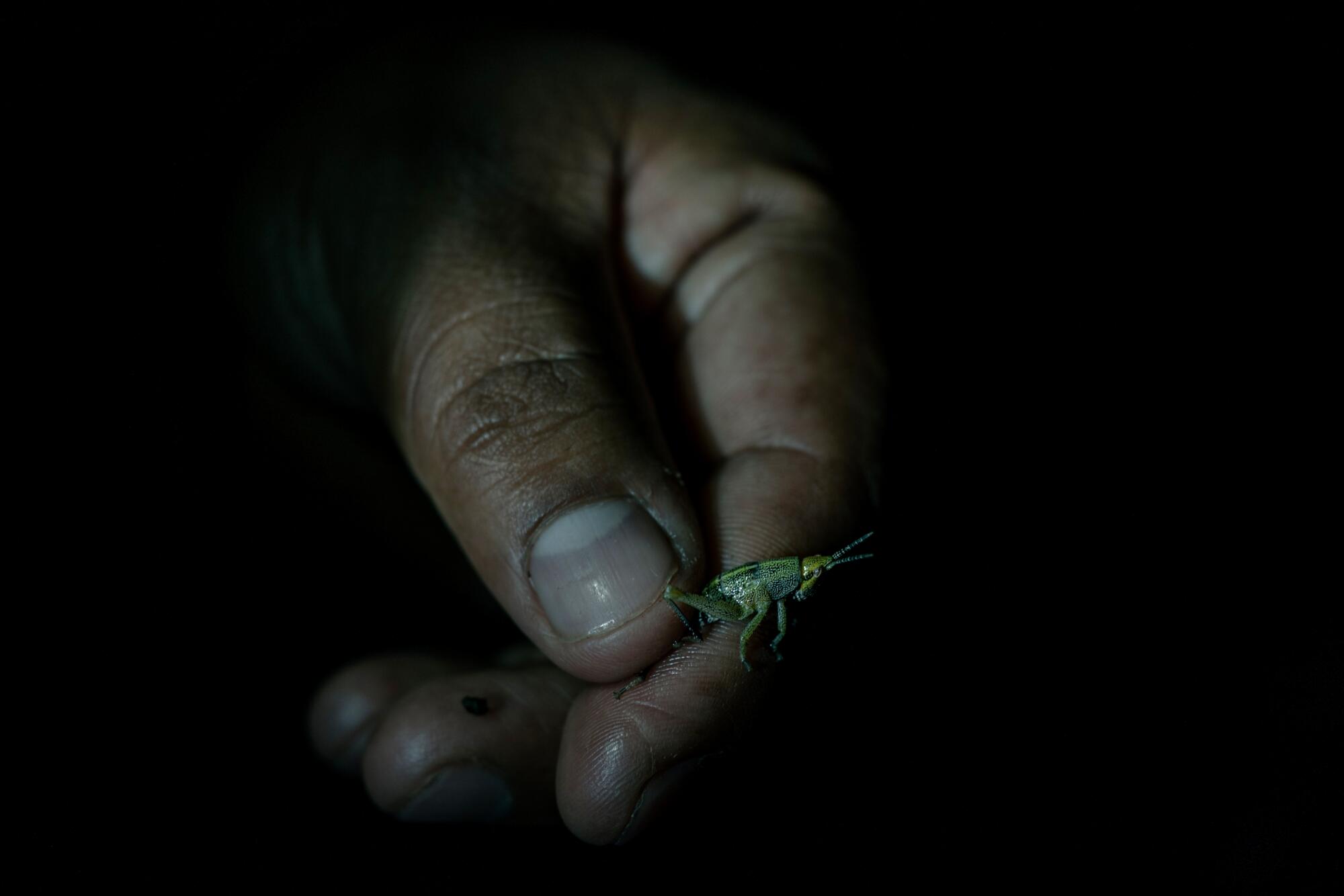
Many people squirm at the mere idea of eating an insect, but grasshoppers — called chapulines in Mexico, a word from the Indigenous Nahuatl language — have been consumed in various parts of the country since pre-Hispanic times, along with hundreds of other insects, including gusanos de maguey (maguey worms), escamoles (ant eggs) and jumiles (stink bugs). They’ve even won a place in the country’s slang: the verb chapulinear can be used in the case of a person who eagerly jumps to date a friend’s current or former partner or a politician who hops between parties to remain in power.
Grasshoppers are often boiled or toasted and seasoned with lemon, salt and chile before they’re rolled into a corn tortilla or plucked out of a bowl. But a push by scientists to encourage their consumption and cut back on ranching has in recent years inspired some new products; grasshopper hamburgers, sauces and pizza among them.
Their numbers are expected to climb with climate change — so perhaps, enthusiasts say, we should all just learn to love them.
Sonora is the cattle capital of Mexico. But prolonged drought is killing off the herds.
::
Fans are quick to list the benefits of eating grasshoppers: They’re chock-full of protein and less polluting than methane-belching cows.
“It’s time to wake up and accept the insects. After all, they’re delicious,” said Hugo Sandoval, who runs the Oaxacan company Inalim, which sells half a ton of grasshopper products a month. He refers to his $4 cans of fried grasshoppers with pepper, chile or peanuts as the perfect beach snacks. “I’d compare them to ham.”
Some say they have a smoky taste. Others suggest burnt cereal. With the insects coated in spices it’s often hard to tell; one could perhaps think of them as a delivery system for flavor.

The harvesting is typically done by individual families that sell their bounty at flea markets, many of them in central and southern Mexico where grasshoppers are popular. There’s no official data on sales or volume, but according to 2010 projections by René Cerritos, a biologist at Mexico City’s National Autonomous University of Mexico, about 200 tons of grasshoppers are harvested in the Puebla-Tlaxcala valley a year. That’s several hundred million grasshoppers, in case you’re wondering.
And they’re not cheap. A kilo, or just over 2 pounds, may cost $12 or more — pricier than some cuts of beef.
Ricardo Muñoz Zurita, a renowned chef in Mexico City, says grasshoppers started to become more popular in fine dining restaurants about 15 years ago as chefs, including those who wanted to incorporate Indigenous foods, started to pay attention to local entomologists who were publishing research on the advantages of eating the insects instead of beef. Livestock contributes 14.5% of all human-induced greenhouse gas emissions, according to the United Nations’ Food and Agriculture Organization.
Grasshoppers are not exactly universally popular, but they’re easy to find in Mexico City. At Muñoz’s Azul restaurants, grasshoppers sprinkled over guacamole are served in a hand-painted ceramic bowl and eaten with tricolored corn tortillas. At the Pixza chain, customers can order pizza topped with them. (In Los Angeles, they’re available at restaurants such as Madre and Guelaguetza.)
And, as it turns out, if you eat one type of bug you might not shy away from others, as is the case in many other countries.
On a recent Sunday evening at Antolina, a Mexican restaurant in the trendy Condesa neighborhood, Luis Perezcano, his wife, Pilar Botaya, and their 23-year-old daughter, Jimena, happily feasted on tacos with cocopaches (black bugs with orange and white spots) and pork belly, red maguey worms and mole, and grasshoppers with the huauzontle herb. They skipped a $31 ant egg dish only because it was “very expensive,” said Perezcano.
“Before it was a curious thing, a game to play with food, ‘Let’s go eat grasshoppers,’” said Muñoz. “The perception has changed.”
It doesn’t hurt that Mexican entomologists are pushing to increase grasshopper hunting. A 2014 study led by Cerritos found that 350,000 tons of grasshoppers could potentially provide 9 million Mexicans with their daily protein for a year.
Scientists suspect grasshoppers will grow more abundant with global warming, although in some parts of the country, an increase in already high temperatures might be lethal. And more of the insects would be unwelcome news for farmers who consider grasshoppers to be a plague and fight them with insecticides.
Cerritos and his colleagues are working on a protocol to help the government regulate the industry. Right now, there are no rules. “The logic is not that you kill them with insecticide but that you take advantage of them and collect them,” said Cerritos. “We need to rediscover what our ancestors practiced.”
Companies that sell processed grasshoppers aren’t waiting for regulation. Chilipines, a Mexico-City based company founded in 2007, sells a smoked grasshopper sauce. “People say, ‘I don’t want to try it,’ and when they do, they say, ‘It’s not the taste I expected, it’s much better,’” said founder Ricardo Redondo, who increases his grasshopper inventory by about 20% every year.
The founders of Chapi, three recent graduates from the National Autonomous University of Mexico, sell grasshopper meat for hamburgers and tacos at bazaars in Mexico City. They also take orders through their social media pages, with a hamburger priced at about $4 for home delivery.
Eduardo Salcedo, who founded Oaxaca-based Terra Sicarú in 2017, has tried to convince restaurants to buy his dehydrated grasshoppers and grasshopper salt by telling them that “a handful of grasshoppers is much healthier than some potato chips.”
He’s sent grasshopper flour to a company looking to create an alternative dog treat and has received requests from influencers for grasshopper-based cookies.
“It’s Instagrammable,” he said simply.
And in 2022, perhaps that’s all that matters.
::
It all begins with the grasshopper hunters.
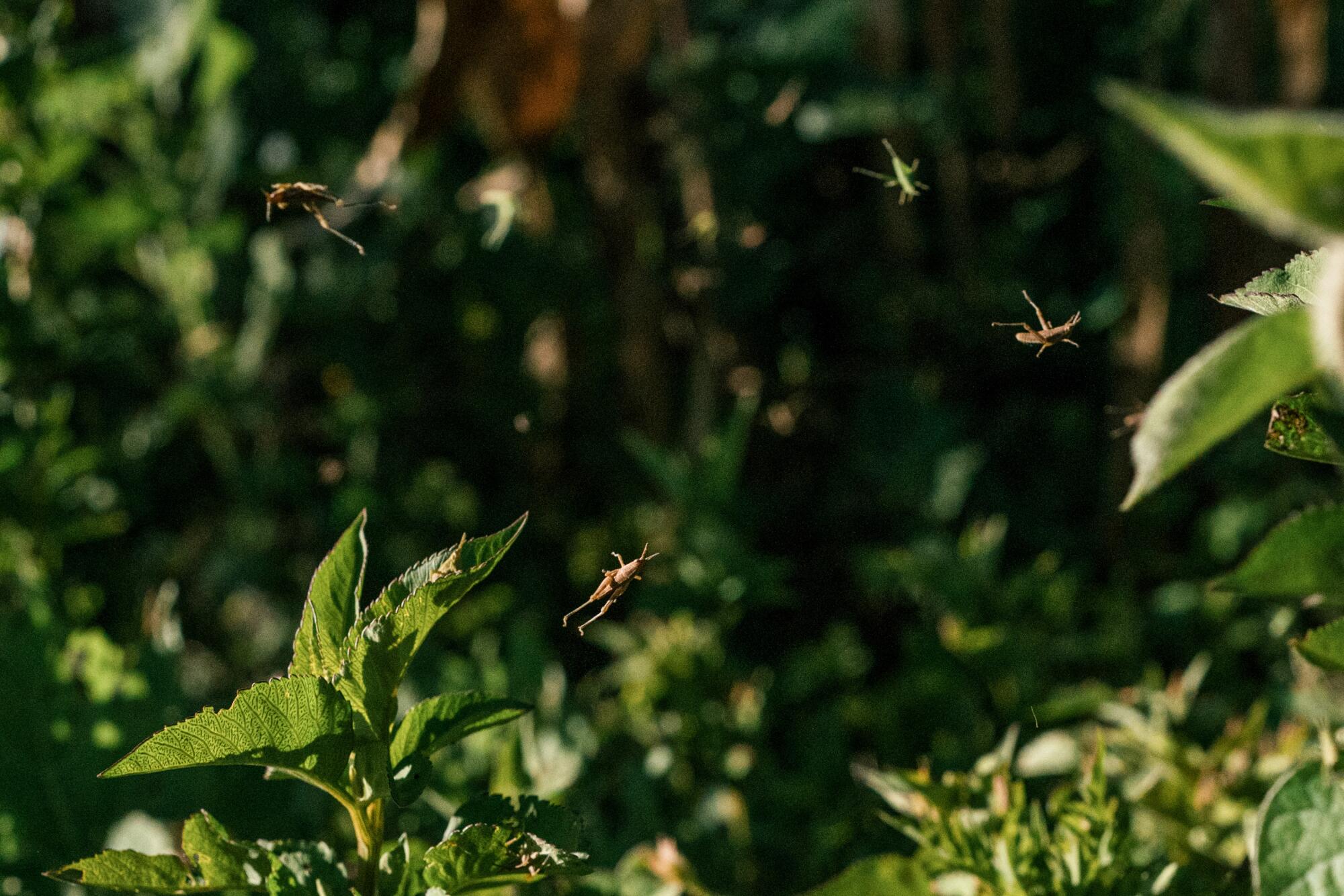
In Santa Maria Zacatepec, a poor town of 14,000 in the state of Puebla, many families hunt grasshoppers to sell in Oaxaca, a state known for its food tourism and where rural families have traditionally caught the insects to eat at home.
The townspeople of Santa Maria Zacatepec say that most of the hunting is done quietly in fields without the permission of the owners, some of whom have been happy to get rid of the insects. But others, angry that strangers are walking all over their crops, shoot warning bullets into the air.
The season starts in the late spring, when baby grasshoppers hatch after the first rains, and continues through the early winter. The families go out at night when temperatures are cooler and grasshoppers are less jumpy.

At first, hunters weren’t sure how to catch them, so they dug deep pits in fields hoping grasshoppers would fall in and be unable to get out. Then they designed a net attached to a bicycle wheel. Now two-handled nets are the tool of choice.
- Share via
Grasshopper hunters in Mexico are feeding a growing market for the insects.
During the hunting expedition in the fields behind the Oxxo convenience store in nearby Huejotzingo, one relatively new hunter, Ricardo Tepale Arévalo, 20, caught half a pound of grasshoppers in just 20 minutes. He said he’s enjoying the extra cash that supplements the wages from his day job driving a dump truck. In four hours, he can make $50.
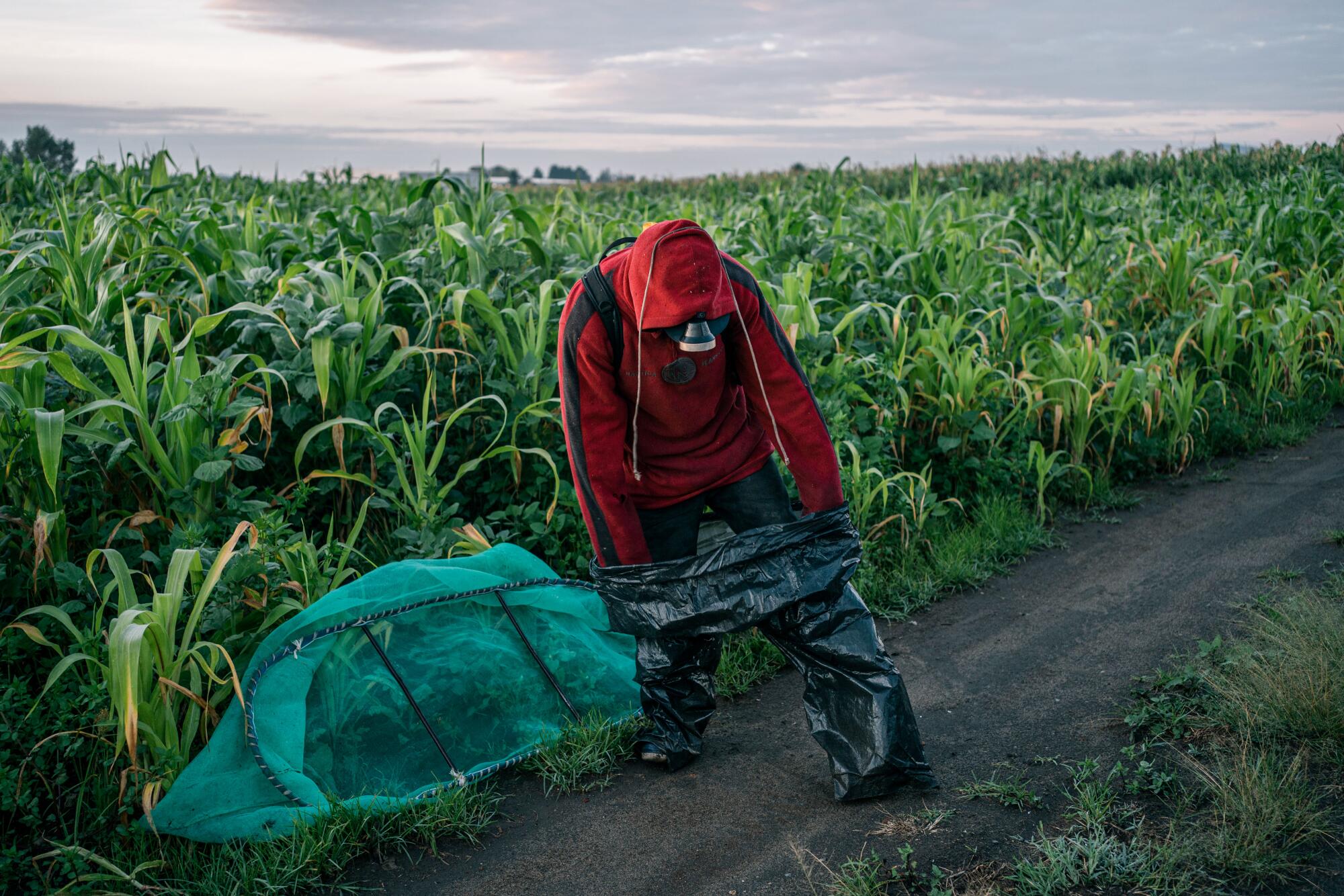
“Little by little, I’m gaining practice,” he said, describing how he caught 17 pounds the previous day.
At 6:30 a.m., the sunrise began to illuminate a water tower and La Malinche volcano. A man biking through a road in the fields passed by. “The grasshopper is sleeping, grab it carefully,” he encouraged them.
As they walked back to their car, the hunters navigated around a wide pit that they hadn’t spotted in the dark. It was at least 30 feet deep, a reminder that their job can be dangerous.
Members of Garcia’s family have been catching grasshoppers around Santa Maria Zacatepec for at least three generations. Hunters also sell their daily catch to the family, and Garcia and his relatives take home about $250 a week selling the grasshoppers to local markets in Oaxaca and other states and to companies that produce processed grasshopper products. They’ve recently begun selling in Puebla, hoping to encourage more people to eat them there.
Garcia speaks nostalgically about his experiences. Sometimes he has slept in the car with a crew of hunters, enjoying the silence and camaraderie. “There’s a tranquility,” he explained. “There are fields where it’s just us in the middle of nowhere and it feels good.” He also likes to eat grasshoppers, suggesting that they taste something like a cross between a shrimp and an oyster.
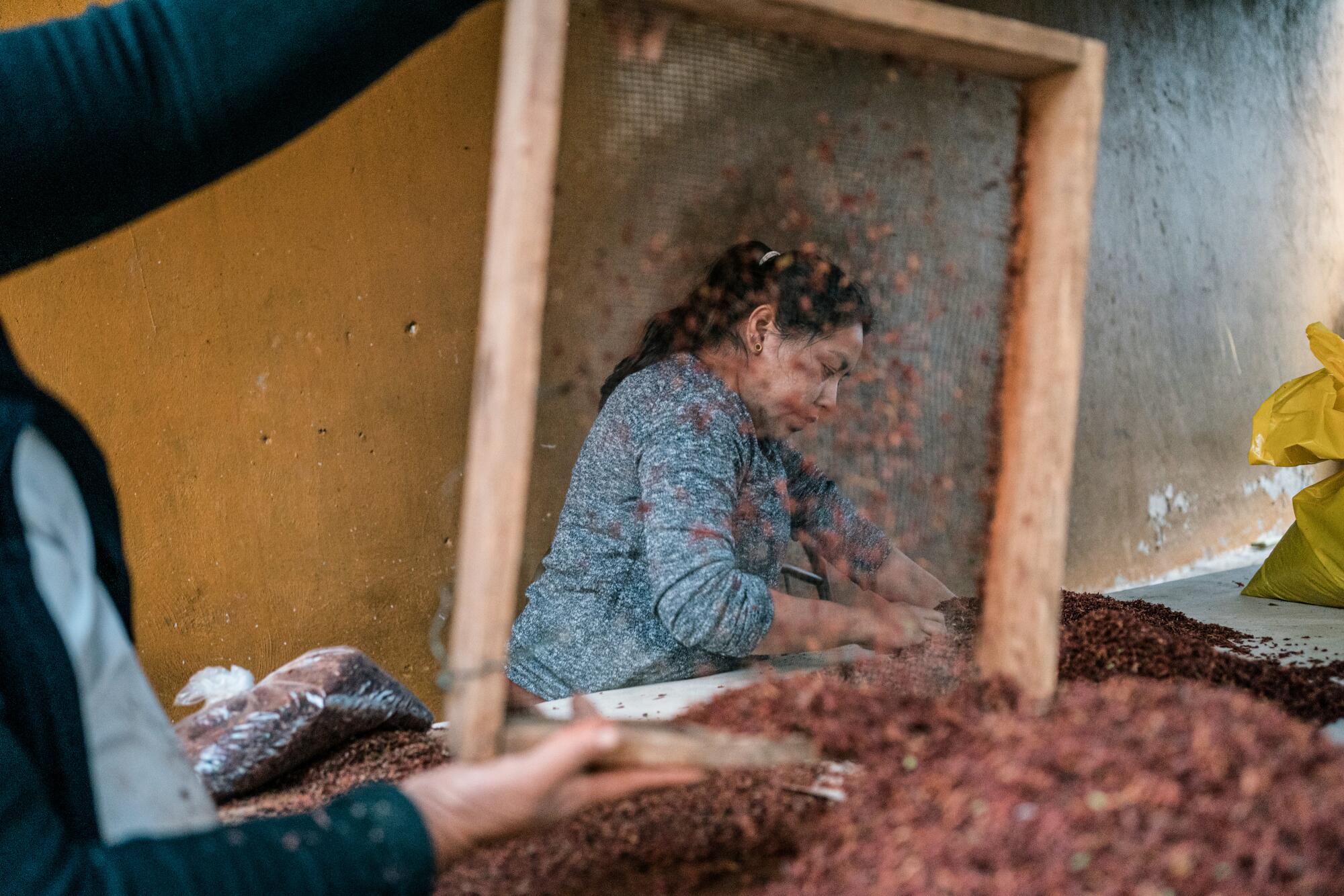
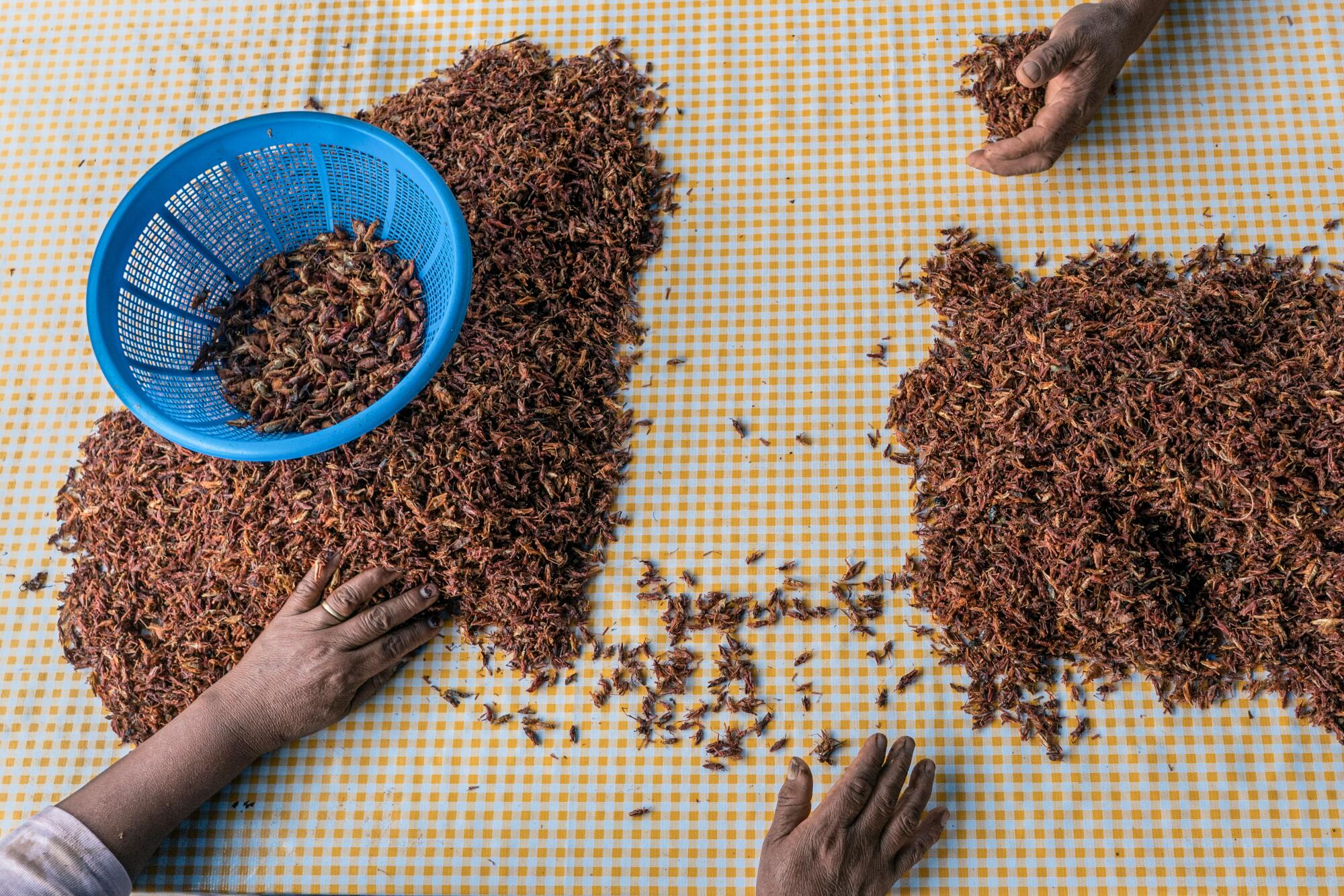
After the morning hunt, 130 pounds of grasshoppers — most of them motionless —were dropped off in large yellow bags at the home of Garcia’s mother, Cruz Perez Villa, and family members got to work cleaning the grasshoppers caught the previous day. They passed a load of the bugs through a filter — picking out a couple of dead frogs — and rinsed them in water.
In the meantime, Perez dumped 17 pounds of grasshoppers in a large boiling pot with lemon juice and 3 pounds of salt and stirred. Within 10 minutes, they had changed from green to red and would soon be put out to dry.
While another batch of grasshoppers cooked, the family, including Perez’s mother-in-law, Elodia Valdez Mejia, her 18-year-old daughter, Alicia, and 32-year-old son, Demetrio, sat around a table to sift through mounds of already dried insects, picking out sticks, caterpillars and anything else that wasn’t, well, grasshopper.
They finished sorting as nighttime fell and loaded a bus with about 450 pounds of the insects for their weekly trip to Oaxaca City, along with other grasshopper sellers, known as chapulineros or chapulineras. At 11 p.m., the bus departed with Perez, Demetrio and Alicia aboard.
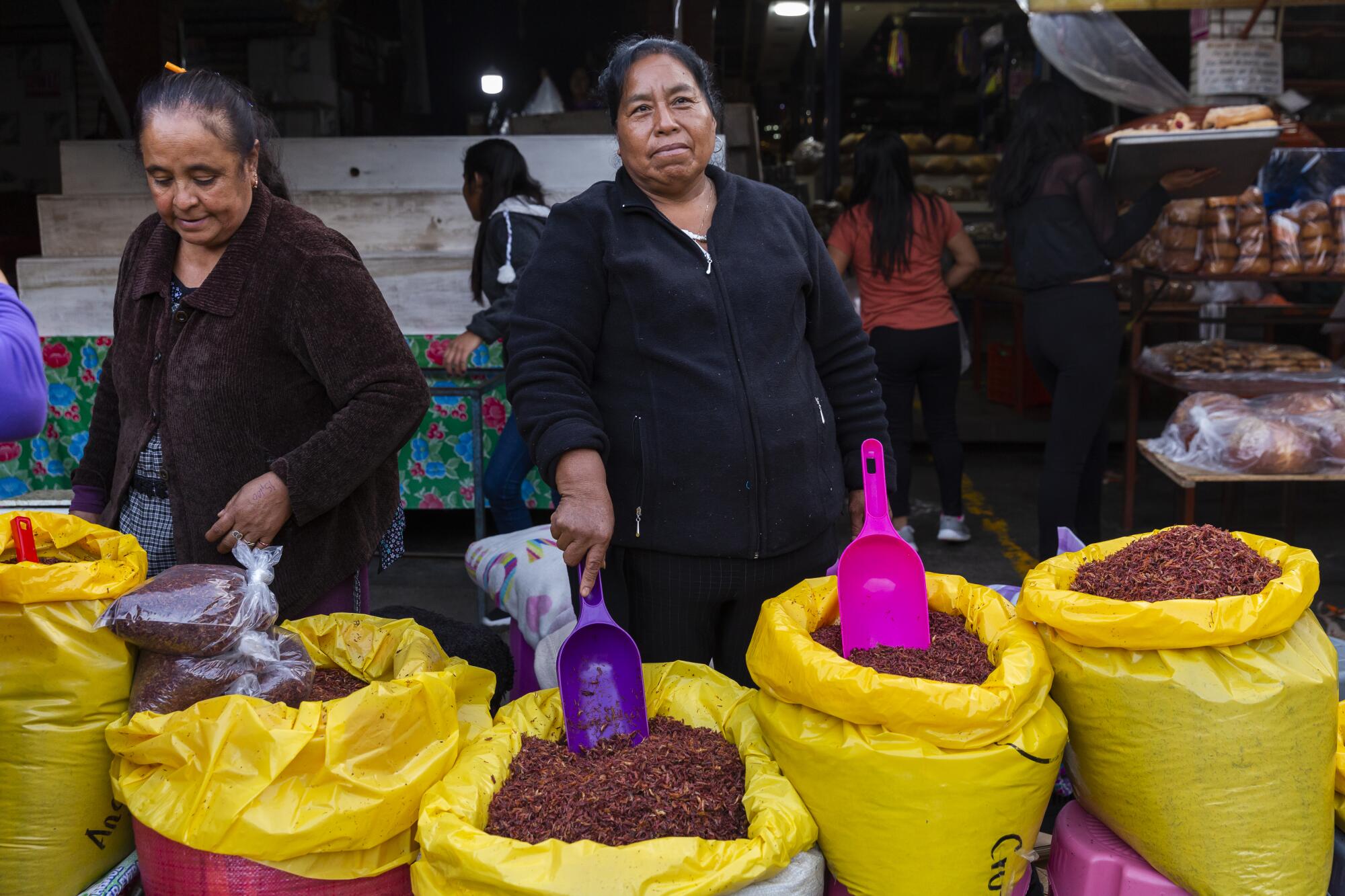
About five hours later, the families walked — bleary-eyed and wrapped in thick blankets— through a dark maze of shuttered stores in Oaxaca’s Central de Abastos flea market. They lined up about a dozen bags of grasshoppers — categorized by size — and waited.
The first customers were women who planned to resell the grasshoppers in the same market or the surrounding area. They stirred their hands through the bags, feeling the texture of the dried insects. Nearly everyone tried bargaining to reduce the asking price for a kilo — $12 — by a few cents.
Doña Chencha, a reseller who goes by her business name, bought 90 pounds from the Garcia family. “Look, a spurt of water came out,” she joked, picking up a big grasshopper and showing it to Demetrio.
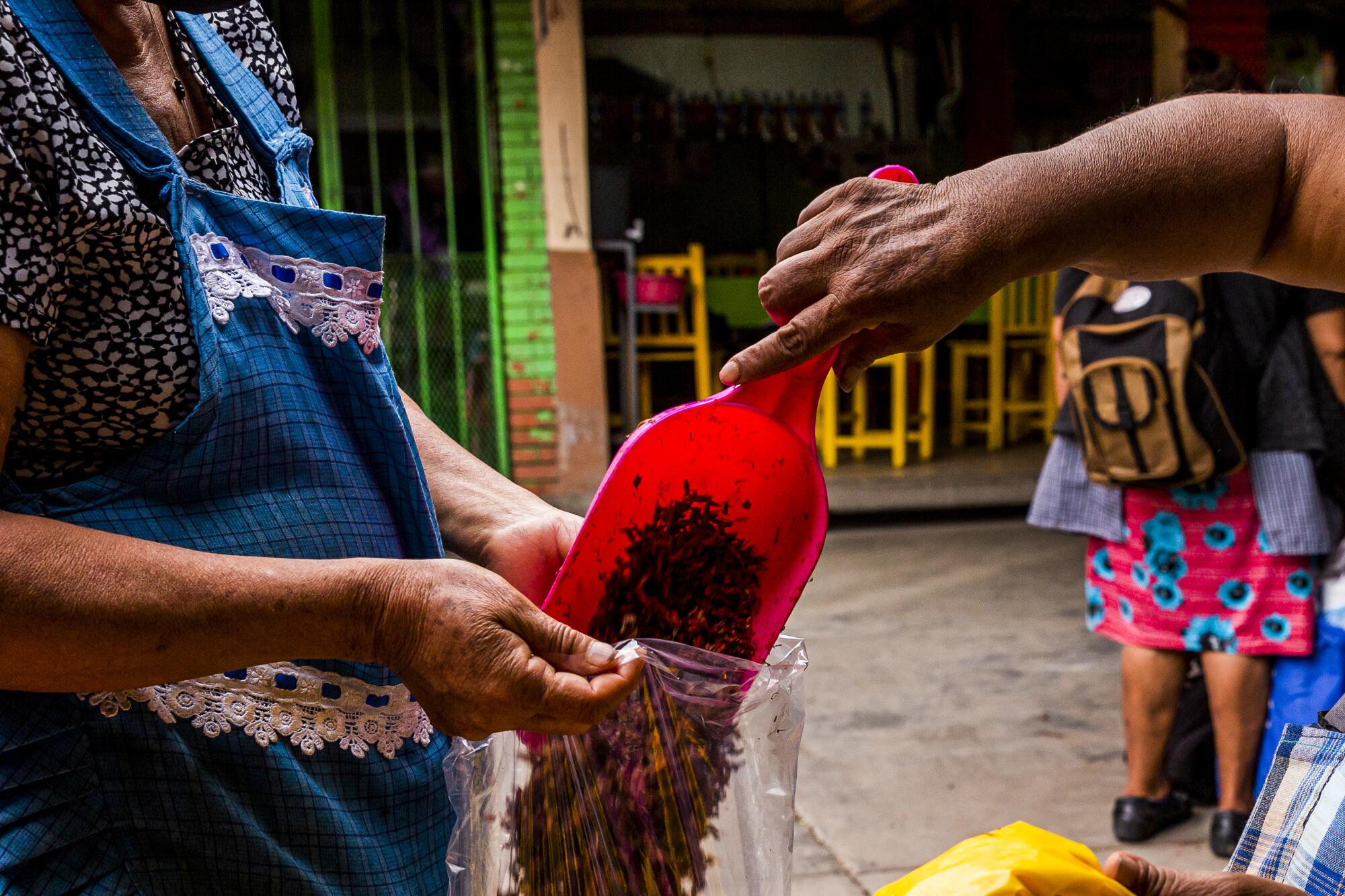
At a street stand, Rosario Camacho, a 44-year-old business consultant from the state of Queretaro, kept a straight face as she ate her first grasshopper. “I’ve actually resisted but everyone has told me to try,” she said. “When I was eating it I thought, ‘How could I be eating this?’ but as you try it, it’s tasty.”
Some Oaxacan chefs like Thalia Barrios Garcia of La Cocina de Humo are trying to encourage diners to eat insects that aren’t as well known. But at her restaurant, Barrios said, she still serves grasshoppers simply — with guacamole— “so that the flavor of the insect isn’t lost.”
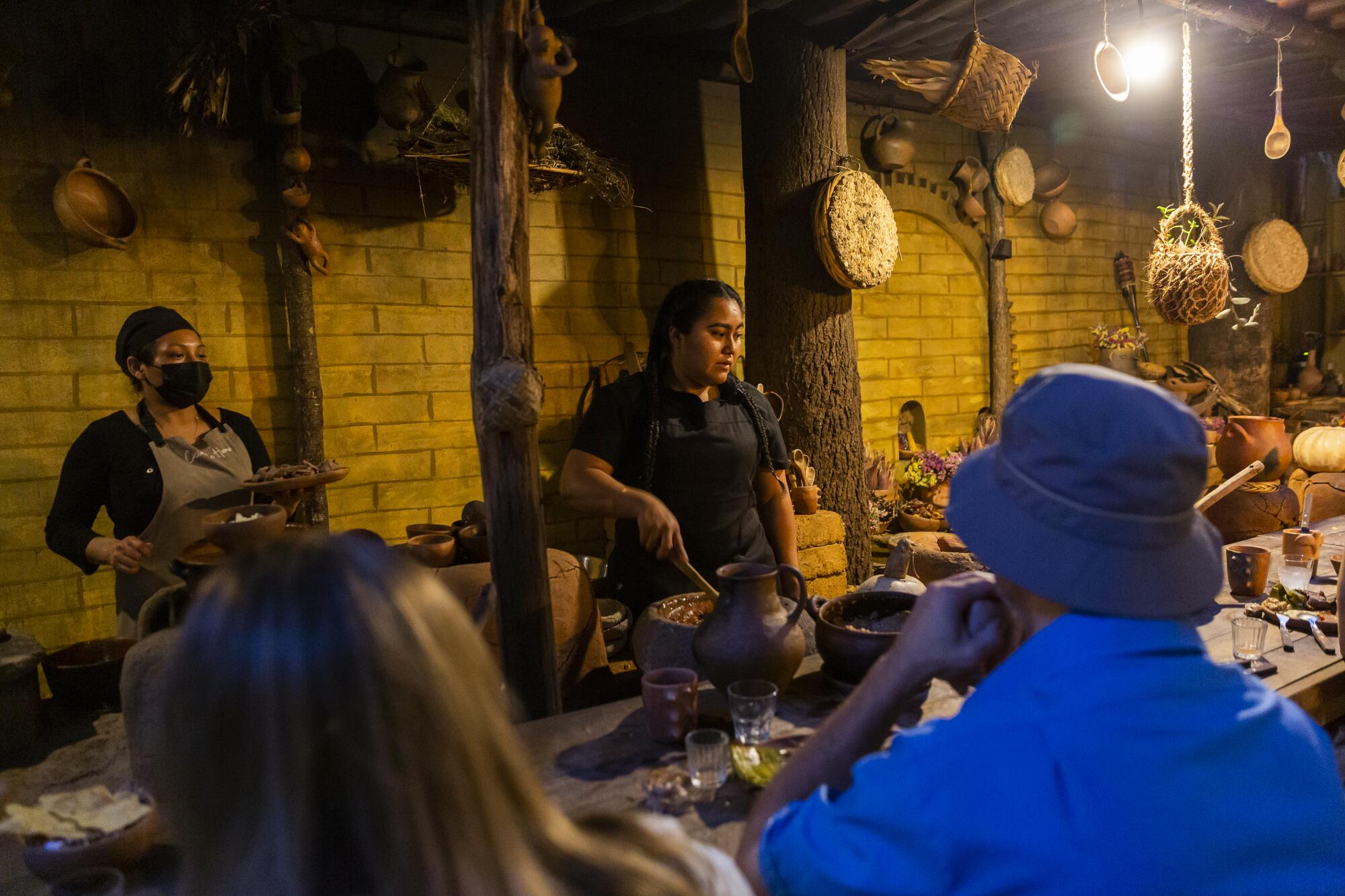
Meanwhile, the Obispo Cocina Rural restaurant in Oaxaca serves 35 different insects. Patrons savor the creatures in a series of “experiences” during which they’re given a few different types to try. Jesus Hanibal Ortiz, its insect “investigator” and a former accountant with a passion for bugs, has traveled deep into Oaxaca’s mountains to find new items for the menu. He’s brought back the picarañama, a large locust, and a grass bug that tastes “between cilantro and mint.”
“Where they’ll tell me there’s an insect, I’ll go,” he said.
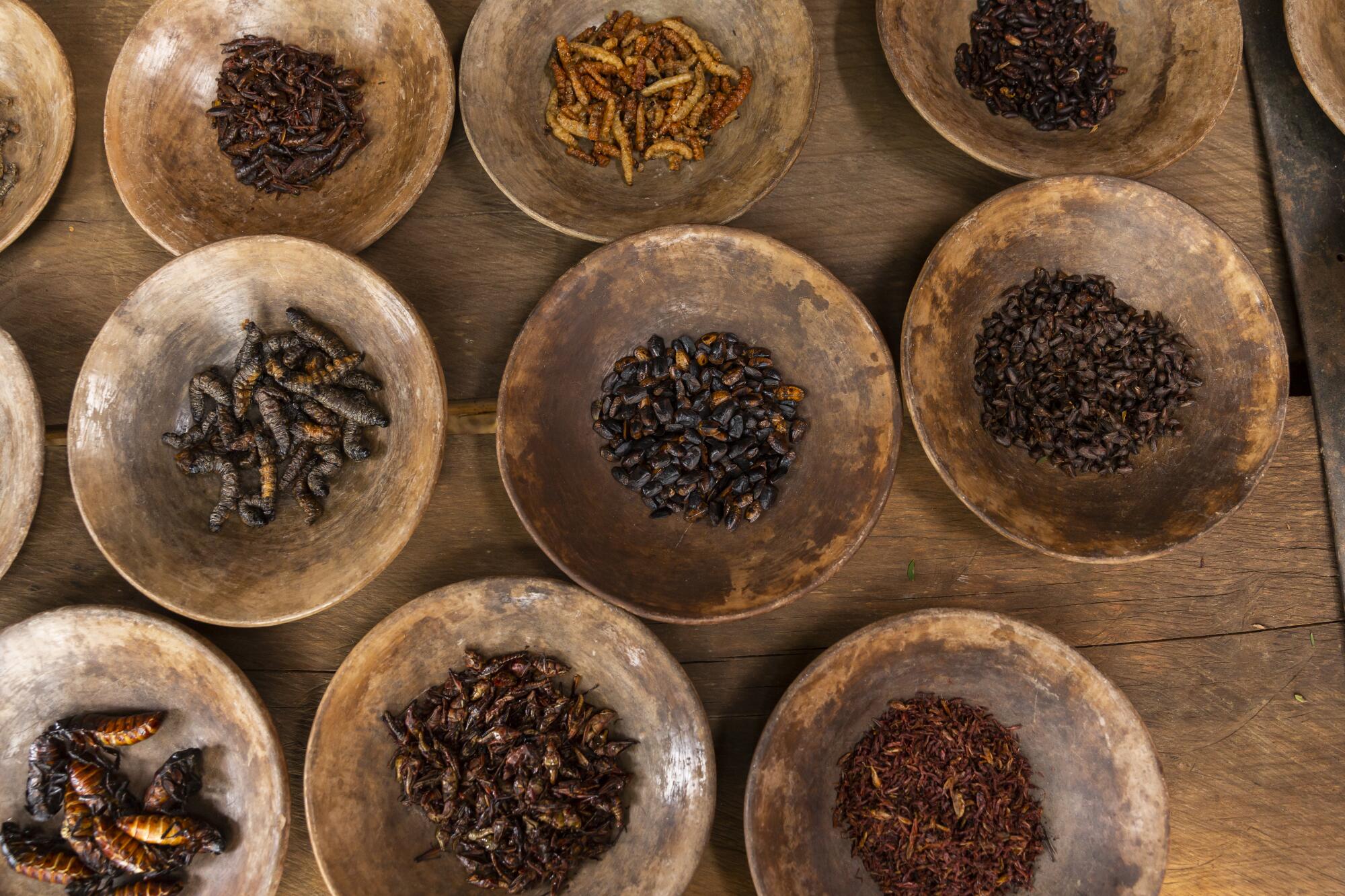
By 6 p.m., the line of grasshopper sellers in the Central de Abastos market had thinned out, but orders for the insects of Garcia’s family were picking up. One woman bought grasshoppers that she’d sell to local bars where they’d be eaten with peanuts and mezcal. A mother and son bought some for a birthday party to serve with buffalo wings.
“One taste,” Perez urged potential customers, extending a large scooper filled with dried grasshoppers.
Juviniano Ruiz, 48, from a town in Oaxaca’s mountains four hours away, arrived when the family had less than 4 pounds left to sell. He used to hunt grasshoppers years ago but said that farmers’ insecticide had driven them away.
Ruiz tried a few grasshoppers that Demetrio offered.
“They’re tasty but expensive,” Ruiz said, grinning.
Seconds later, he gave in to temptation.
More to Read
Sign up for Essential California
The most important California stories and recommendations in your inbox every morning.
You may occasionally receive promotional content from the Los Angeles Times.











